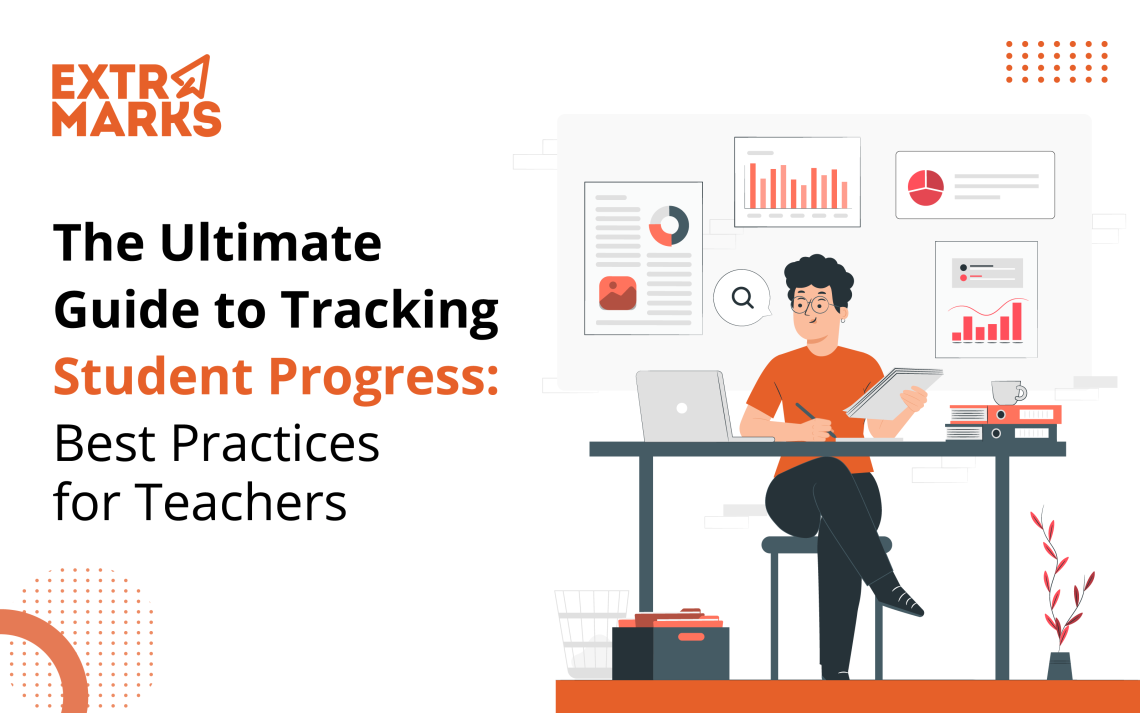The Ultimate Guide to Tracking Student Progress: Best Practices for Teachers

Keeping track of how your students are doing can feel like a lot, especially when every child learns in their own way and at their own pace. Some understand the lesson quickly, while others need a bit more time and support. That’s completely normal. As a teacher, you want to make sure no one falls behind, and for that, you need simple and clear ways to check progress. In this blog, we’ll walk you through different methods you can use to track student progress. These strategies will help you understand where your students stand and how you can support them better moving forward.
Most Important Student Progress Data Teachers Should Track
As a teacher, there’s so much more to track than just test scores. Students are growing in every direction, and your role includes keeping an eye on the full picture. Tracking the right data points helps you understand where each student stands, what they need, and how you can support them better. Let’s break down what really matters.
1. Academic Performance Data (Test and Exam Scores)
Let’s start with the basics. Test and exam scores still matter, but they’re only a small part of the bigger picture. Keep track of core test results, daily assignments, and how students perform cumulatively over time. Formative assessments like class quizzes and quick checks during lessons help you understand how well students are picking up concepts in the moment. Summative assessments at the end of units or terms give you a clearer view of long-term retention. Even scores from in-class activities can tell you a lot about student effort, consistency, and areas that need support.
2. Student Classwork, Homework, and Assignment Completion Data
Regular completion of tasks tells you a lot more than you might think. It shows discipline, time management, and how seriously students are engaging with the subject. If someone is missing work often or rushing through assignments, it could be a sign that they’re struggling or feeling overwhelmed. On the other hand, steady and consistent work shows a growing sense of responsibility.
3. Attendance and Punctuality Data
Being present on time, every day, forms the base of steady learning. If a student is frequently absent or late, it starts to affect their academic progress and connection with the class. Tracking this helps spot early warning signs so you can step in before small issues become bigger ones.
4. Class Participation and Interest
Is the student raising their hand? Are they curious, asking questions, or joining in discussions? Participation is a big sign of engagement. It tells you whether a student is connecting with what’s being taught or just going through the motions. Sometimes, even a quiet student shows deep interest through attentive listening or thoughtful written answers. Keep an eye out for all forms of engagement, not just the loud ones.
5. Behavioural Patterns Data
Behaviour in the classroom often reflects what’s happening inside a student’s mind. Are they restless, distracted, or frequently off-task? Are they showing signs of aggression or withdrawal? Keeping track of behavioural patterns helps you support students emotionally and socially, not just academically.
6. Basic Skill Development (like reading, writing, and math)
Skills like reading, writing, and math are the foundation of all learning. But in today’s world, it goes beyond that. Literacy and numeracy still matter, but so do digital skills, problem-solving, and everyday life skills. NEP 2020 encourages us to prepare students for real life, not just exams. When you track how well a student reads, reasons, or uses a computer, you’re helping them become future-ready.
7. Confidence and Emotional Well-being
How a student feels in class can affect how much they learn. Are they confident enough to speak up? Do they seem anxious or afraid of making mistakes? Emotional well-being influences learning far more than we realise. Teachers who watch for changes in mood or behaviour are better equipped to support their students in a deeper way.
8. Learning Objectives and Milestones
Every subject has clear goals. Maybe it’s mastering a chapter, learning a new skill, or finishing a project. Tracking how students move towards these goals helps you adjust your teaching pace. When you know who’s moving ahead, who’s catching up, and who’s falling behind, it’s easier to step in with support or challenge as needed. Small milestones give clear markers of growth.
9. Student Engagement Levels
This goes beyond just showing up. Is the student mentally present? Are they trying new things, taking risks in learning, or just sitting passively? Engagement is often what separates deep learning from surface-level understanding. Use different class activities, group tasks, and reflections to track who’s truly involved.
10. Student Feedback
Ask your students how they feel about what they’re learning. Their insights often highlight what’s working and what’s not. It also builds trust and shows them that their voice matters. Whether it’s a quick check-in or an anonymous form, student feedback is a great tool for improving teaching and strengthening the classroom bond.
11. Parent Communication and Involvement Data
The more you involve parents, the better the support system for the student. Keep track of how often you communicate with parents and how engaged they are in their child’s learning. When teachers and parents work together, students get the best chance to succeed.
12. Holistic Progress Metrics
You can’t talk about student progress today without mentioning holistic development. As guided by NEP 2020, schools are moving toward tracking co-scholastic areas like art, sports, teamwork, and personal growth. Tools like CBSE’s Holistic Progress Cards encourage teachers to consider self-assessment, peer feedback, and even emotional development. When you track the full picture, not just test scores, you support the whole child, not just the student.
How to Track Student Progress: A Step-by-Step Guide
If you’re trying to create a learning environment where students feel supported and motivated, tracking their progress is something you just can’t ignore. Here’s a step-by-step guide to help you with it:
1. Set Clear Course Goals
Start by setting clear, simple goals for each subject or chapter. For example, if you’re teaching fractions, make sure students know what they should be able to do by the end of the topic. Whether it’s solving word problems or understanding equivalent fractions, having a goal gives both you and your students a direction to follow.
2. Use a Mix of Assessment Methods
Use different ways to check if students are learning. Some may do well in quizzes, others might shine in group activities or oral responses. You can try worksheets, small group discussions, short tests, drawing-based activities, or even a class quiz game. Mixing it up keeps students interested and gives you a better picture of how they’re doing.
3. Choose the Right EdTech Platform
Let’s be honest. Tracking student progress manually with Google Sheets or Excel gets boring and time-consuming. It can feel like you’re spending more time entering data than actually teaching. This is where a smart EdTech platform can make a big difference. A platform like Extramarks Smartclass Plus gives you built-in tools to track progress, share instant feedback, and get insights into student engagement. It turns hours of manual work into just a few clicks.
4. Build a System to Monitor Progress
Once your platform is ready, create a system that works for you. Track things like how many students are completing lessons, how they’re scoring in assessments, and how actively they’re participating. This data will help you understand where students are thriving and where they might be falling behind.
5. Check In Regularly
Don’t wait till the term ends. Keep checking in. Use classwork, homework, or even a five-minute quiz to see how students are doing. If most of the class struggles with a topic, you’ll know it needs revisiting.
6. Give Feedback That Helps
Students want to know where they stand, but more importantly, they want to know how to get better. Make sure your feedback is clear, specific, and given on time. For example, after a play on the history of India, you could give pointers on voice tone, body language, and knowledge. The idea is to guide them, not just grade them.
7. Adjust Your Teaching When Needed
If your progress tracking shows that many students are stuck, it’s time to change something. Maybe the content is too hard, or maybe it’s just not clicking with them. Offer a different explanation, share extra resources, or set up small group sessions. Being flexible shows students that you’re truly invested in their learning.
Why Tracking Student Progress Matters
In today’s evolving educational landscape, tracking student progress is no longer just a good practice—it’s a core expectation across all school systems in India and key part of modern teaching. The NEP 2020 emphasises regular, formative assessments and 360° progress cards that go beyond marks to include skills, values, and self-reflection. Boards like CBSE are introducing Holistic Progress Cards and tools like SAFAL to support ongoing tracking. Even ICSE, state boards, and international curricula are moving towards more continuous evaluation. Regardless of the board, progress tracking is now a key pillar of quality teaching and student success.
1. Identifies Learning Gaps Early
Sometimes students fall behind quietly. With regular progress tracking, you can spot those gaps before they grow into bigger issues. It helps you step in at the right time, offer support, and make sure no one is left behind.
2. Enhances Learning Outcomes
When you keep checking in on how students are doing, you give them a better chance to truly understand what they’re learning. Over time, this regular check-in builds stronger understanding, better recall, and clearer thinking.
3. Improves Academic Performance
Let’s be honest. Marks matter. Regular monitoring gives you data that helps improve scores in a smart and focused way. You can use that data to change your teaching method or give a little extra attention where it’s needed. Over time, this kind of smart teaching starts to reflect in student performance.
4. Supports Personalised Teaching
Not every student learns the same way or at the same speed. Tracking helps you see who needs more time and who’s ready for a challenge. You can adjust your methods, split the class into groups, or give one-on-one attention. It gives you the flexibility to teach each student based on their own pace and needs.
5. Promotes Student Self-Awareness
When students are aware of their own progress, they start thinking differently about learning. They begin to reflect on what they’ve understood, set goals, and track their own improvement, becoming more involved in their academic journey.
6. Builds Student Confidence
Even small wins can make a big difference. When students see that they’re improving, it boosts their confidence. This is especially powerful for those who have struggled in the past. Progress becomes their motivation.
7. Boosts Course Completion Rates and Learner Engagement
When students know that their progress is being tracked, they tend to take learning more seriously. It encourages them to show up, participate, and finish what they start. You’ll notice better attention in class and fewer incomplete assignments.
8. Drives Continuous Improvement
Tracking doesn’t just help students. It helps you, too. It gives you feedback on your own teaching—what’s working, what’s not. You can try new approaches, make changes, and keep improving your classroom strategies.
9. Streamlines Decision-Making
With clear data in front of you, decisions become easier. Whether it’s adjusting a lesson plan or offering extra help to a student, tracking gives you the clarity to make smarter, faster choices.
10. Enhances Accountability and Motivation
When progress is tracked openly, both teachers and students stay more focused. Everyone knows what they’re working towards. It brings a sense of shared responsibility and keeps the classroom goals in view.
11. Informs Holistic Development
Progress isn’t just about test scores. It includes behaviour, co-curricular activities, and emotional growth, too. With the NEP 2020 pushing for overall development, tracking helps you support students in every area of their life at school.
How Extramarks Can Help Teachers Track Student Progress
Extramarks understands that keeping up with every student’s journey takes time, effort, and the right tools. That’s why it offers smart solutions to make your job easier and more impactful:
- Real-Time Insights: Get instant access to detailed performance data through the Extramarks Teachers Portal.
- Customised Analytics: Spot where each student is doing well and where they need help. Plan your lessons around their actual needs.
- Assessment Centre: Easily schedule and conduct regular tests. Get automated reports that save you time and give you clear insights.
- Interactive Dashboards: Visualise class trends and track individual student journeys all in one place.
- Engagement Monitoring: Keep an eye on which students are actively participating in lessons and who may need a little extra attention.
With these tools, Extramarks helps you stay in control of your classroom while making sure every student gets the attention they deserve.
Conclusion
Tracking student progress is not just a task to tick off but a part of everyday teaching. It helps you understand your students better and support them where it truly matters. With the right methods and a little consistency, you can make learning more meaningful for everyone in your class.
Frequently Asked Questions
1. What should I do if I notice a student is struggling?
If you notice a student is struggling, it’s important to take action right away. Consider providing additional support or resources and meeting with the student and their parents to discuss a plan
2. How often should I track student progress?
Tracking student progress should be an ongoing process throughout the school year
3. How can I involve parents in the tracking process?
Involving parents in the tracking process can be as simple as sending regular updates on their child’s progress or scheduling parent-teacher conferences.
4. What’s the best way to track student progress?
There’s no single magic formula, but the best way is to mix a few things together. Start with regular check-ins like short quizzes or class activities. Pay close attention to how students are doing during lessons. And if you have access to digital tools, use them. When you combine these, you get a clear picture of how each student is doing and where they might need a little extra help.
5. What tools or techniques can help me monitor and improve student learning outcomes?
Using a mix of regular assessments, student feedback, and digital tools works well. Platforms like Extramarks make this easier by offering interactive tests, personalised learning paths, and real-time progress reports. It helps you spot learning gaps quickly and support each student better.
Last Updated on July 4, 2025
Reviewed by

Priya Kapoor | AVP - Academics
Priya Kapoor is an accomplished education professional with over 18 years of experience across diverse fields, including eLearning, digital and print publishing, instructional design, and content strategy. As the AVP – Academics at Extramarks, she leads academic teams in creating tailored educational solutions, ensuring alignment with varied curricula across national and international platforms...read more.









